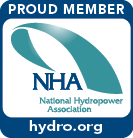 EME has supported the hydro power generation for over 30 years. Prior to the widespread availability of large-scale Finite Element Analysis, generator design & fatigue calculations were performed primarily using classical “closed form” calculations, stress concentration factors, and fatigue strength correction factors. The stator and rotor structures were considered as the fabricated components that they are and stresses calculated based on the specific construction methods and loading (static, dynamic, and electromagnetic) which the structure experienced.
EME has supported the hydro power generation for over 30 years. Prior to the widespread availability of large-scale Finite Element Analysis, generator design & fatigue calculations were performed primarily using classical “closed form” calculations, stress concentration factors, and fatigue strength correction factors. The stator and rotor structures were considered as the fabricated components that they are and stresses calculated based on the specific construction methods and loading (static, dynamic, and electromagnetic) which the structure experienced.
Recently there has been movement in the industry to apply ASME Boiler and Pressure Vessel Code to the analysis of generators – is that the appropriate standard? Is it a good fit for the application? When designing, uprating, or changing the operating duty of a generator, what are the key elements that should be considered?
The typical areas for consideration include: Turbine/Gen shaft and couplings, Rotor Spider, Spider hub to shaft fit and keys, Spider to rim iron fit, Pole fixation to the rim, and the Thrust/guide bearing brackets. Additionally, there has been a tendency to rewind stators using single-turn stator windings, which often increases unbalanced magnetic pull between the stator and rotor. The operation of hydro generators is also changing to support a changing grid which contains more intermittent operating renewables, which increases the need for ancillary services support. This is placing new types of duty on hydro generators including more starts and stop cycles, load following (thermal cycling), and operation at unstable hydraulic conditions (higher vibration). The objective of typical studies – uprate, life extension analysis, or evaluation for ancillary services, is to determine: Can the components take the loading? How long will they last? What should be the inspection interval? What areas of the components should be inspected and what should the inspection consider? What additional monitoring (if any) should be employed?
One approach which EME uses based on fracture mechanics, is to calculate the static stresses, the cumulative fatigue damage, and the theoretical maximum allowable crack that would not propagate. This is accomplished by:
- Calculate by FEA and classical analysis the nominal Von Mises (distortion energy) stresses in the component at full load in normal operating condition and compare the results against criteria commonly used in the industry
- Calculate by FEA the Von Mises stress ranges in the component for different fatigue cycles an compare the results against S-N fatigue curves commonly used in the hydro industry and evaluate the cumulative fatigue damage.
- Calculate the theoretical maximum allowable crack which is not to propagate under the maximum load in normal operating condition using the methodology found in the API159-1/ASME FFS-1 Standard
- Calculate the critical crack size for upset conditions (short circuit, runaway, etc.) and insure that all components have a suitable safety margin such that cracks would be detectable before an upset occurred that would cause a major component failure.
When applying the ASME code to fatigue analysis (Section VIII, Div 2, Part 5.5) there are some differences compared to the approach described above. The method used to evaluate components in fatigue is primarily a stress-based method, using the Von Mises stress ranges given by both closed form and FEA modeling – similar in that respect. A hydro generator however, differs greatly from a pressure vessel in the manner of loading and in manner and consequences of failure, as well as damage tolerance. Application of the ASME Code can result in much larger factors of safety, which sounds positive, however it may also disqualify a piece of equipment that has been in-service satisfactorily for many years. When applying the Code to a new design or upgrade, the costs will also likely increase as a result of satisfying criteria with much higher factors of safety . For example, when a machine that has been successfully operating for 50 or more years is ‘condemned’ when applying the Code methodology, it suggests that the best answer may be determined by an alternate methodology..
Development of a standardized methodology for consideration of fatigue life is an excellent objective and it is time for the industry to come together and develop an optimized approach for hydro generators.
Let us know what you think; we’d welcome your comments and suggestions.





